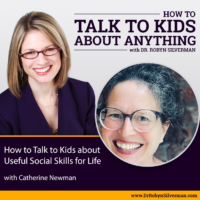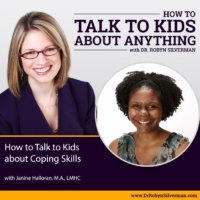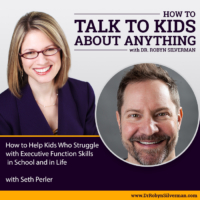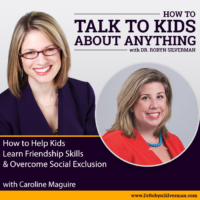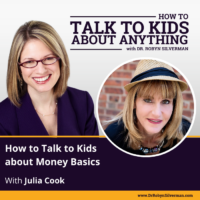Podcast: Play in new window | Download
Subscribe: Apple Podcasts | RSS | More
How to Talk to Kids about Money Skills
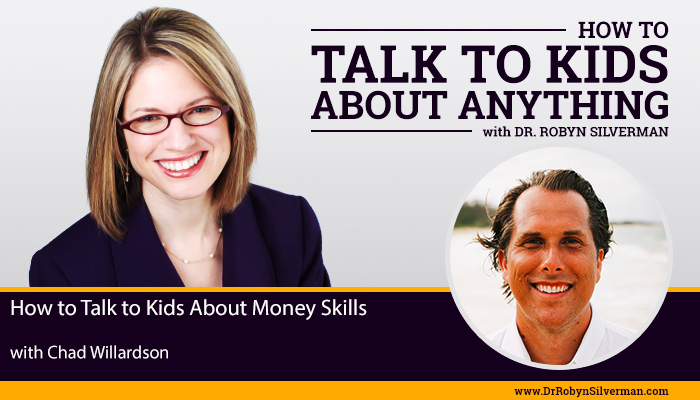
This podcast will focus on how to talk to kids about the financial skills they need to manage money throughout their lifetime. From saving, spending wisely, giving and investing, this podcast gives you the talking points! Dr. Robyn Silverman interviews financial advisor and best-selling author of Stress-Free Money and Smart, Not Spoiled, Chad Willardson.
Special guests: Chad Willardson
 A recent study reports that although 75% of parents think that providing financial guidance for their kids is part of their duty as parents, only 36% report having the clarity on how to do that. Managing money is rarely covered in schools and as parents, it’s difficult to know where to start. What should kids be learning about saving, spending, giving and investing? What pitfalls should they be avoiding so that they don’t wind up going down a long and windy rabbit hole only to come up short? And how can we assure that the skills we provide help them to become money smart and anything but spoiled and entitled? With so much to buy, buy, buy it can be a challenge to help them to learn to save, earn, invest and give to others who are less fortunate. Today, we are going to money school with my guest, Chad Willardson.
A recent study reports that although 75% of parents think that providing financial guidance for their kids is part of their duty as parents, only 36% report having the clarity on how to do that. Managing money is rarely covered in schools and as parents, it’s difficult to know where to start. What should kids be learning about saving, spending, giving and investing? What pitfalls should they be avoiding so that they don’t wind up going down a long and windy rabbit hole only to come up short? And how can we assure that the skills we provide help them to become money smart and anything but spoiled and entitled? With so much to buy, buy, buy it can be a challenge to help them to learn to save, earn, invest and give to others who are less fortunate. Today, we are going to money school with my guest, Chad Willardson.
Bio
Financial advisor, Chad Willardson, CFF, CRPC®, AWMA®, is the President of Pacific Capital, a fiduciary wealth advisory firm he founded in 2011 that serves entrepreneurs and families. He is the best-selling author of two books- Stress-Free Money and now, Smart, Not Spoiled: The Seven Money Skills Kids Must Master Before Leaving the Nest.
Important Messages:
- Talk about the why behind spending, saving, sharing/giving. What is the purpose of each category? What do you want to give money
 to? What do you care about? The important thing is the principles and the purpose behind each category. Kids are all different. Some kids really love to save and like to see the money build up and other kids, once the money touches their hands they already have 5 things they’re ready to spend it on.
to? What do you care about? The important thing is the principles and the purpose behind each category. Kids are all different. Some kids really love to save and like to see the money build up and other kids, once the money touches their hands they already have 5 things they’re ready to spend it on. - Why do we need to save? You have to be aware of money coming in and money going out- there will be things in the future that cost money! Your first used car, for example. A ticket to an amusement park. College. Service trip. “There will surely be something down the road they’ll want to do, experience or buy and that will likely take more money than they can earn in that particular week or month.”
- Use examples: Times when you had to use more money than what it takes to go to the movies.
- Benefits or Bust? Plus the Blueprint for what to do instead.
- Borrowing money from a friend.
- Benefit: Enjoy this game immediately.
- Drawback: Borrowing money from a friend for ‘wants’ or immediate desires usually leads to remorse or regret. Drawbacks: (1) Borrowing money from a friend or others to do things that are impulsive or ‘in the moment,’ providing pleasure or immediate gratification usually leads to regret or remorse afterwards. (2) It also makes it so your child isn’t learning financial responsibility when he is borrowing for his wants. (The video game, to him, might feel like a need but it’s really a want). When we borrow for our wants, we set up a pattern of financial misbehavior that can continue on into our late 50s, 60s, or 70s. (3) He may ruin that relationship if he doesn’t pay that person back in a timely manner.
- Blueprint: Borrow money ‘in house’ but pay interest. Have a contract. Pay interest. Written contract- if you borrow 20 bucks, you are going to pay more than 20 bucks back. Borrowing has a cost. OR- productively earn it on your own before you can get that game. Plan- earn some of it and borrow some of it. Learn about loans and interest. Problem is the bank of Mommy and Daddy. Not teaching kids to fish- just throwing fish at them!
- Contract: Ryan borrowed 20 dollars from Dad. Ryan is paying back 5 dollars per week for 4 weeks. On the final payment, Ryan will pay an additional 1.50 dollars of interest. If there is a late payment or if it goes beyond the payment date, there is a penalty of another 5 dollars. (Teach kids the real world of lending. Your credibility and accountability as a borrower will actually matter in the future. “If you do this deal good and pay your money back on time, maybe your interest is just 5% next time. If you don’t, I’m going to be a little more hesitant to lend you money. I may tack on 10% interest to the next loan. And that’s how the real world works!”
- A parent doesn’t tend to have money laying around—and wants to get her child a credit card so that when they are with friends, they always have money to buy a snack or something small they might need or want.
- Benefit: Social acceptance of being able to purchase something at the same time as friends.
- Drawbacks: (1) You are setting up the same consumerism, ‘borrow to fit in,’ borrow for instant gratification, borrow to keep up with the Joneses’ mentality. (Financial ruin that come to families even who have really high incomes- who have this mentality- keep up with IG, spend money to keep up with Joneses) Credit cards for kids- not a good idea- credit card for adults- I don’t think it’s a good idea either.
- Did you know? You can build the credit of y our kids by allowing them to be an authorized signer on a credit card you already pay off each month. Added on to the CC.
- If you don’t have money, someone else does! Find a way to create value to earn that money. Do some jobs, ask for opportunities instead of just trying to get money for nothing to spends it on wants for the moment.
- Investing when child is young. Analogy- planting seeds. “When you are investing, you are planting seeds for the future. Trees have lots of leaves and branches and provides a lot of shade and comfort in the future—and it may even provide some fruit! The tree is what you want to provide in the future- in order to get that, you have to plant seeds early. You need time to grow that tree. You can’t rush the process. You can’t wait until you’re 25, or 45 or 65- and then just say I’ll put extra water on it and the tree will grow faster- that’s not how this works! You’re going to have problems! You have to plant the seeds and let that growth happen over time.
- Compounding– incredible to think about the riddle. Would you rather have 100,000 a day for 30 days or I give you a penny and double it each day over the 30 days. It becomes 5.4 million dollars! The idea of compounding and doubling each day isn’t realistic BUT the idea of compounding and investing and growing is important. Money can grow on it’s own. If you invest now, you won’t have to work later because you were smart with your money now and allowed it to grow.
- Four categories of investing for growth: Planting the seed- long timeframe in front of them. Stocks, Bonds, Real Estate and private businesses. Now there are crypto currencies- but the others are 4 categories that have been around for a century.
- How do we talk about it? Talk about the things that they know. Netflix show, see a Nike commercial, amazon, Disney show, coke, Costco. See them as products to consume. These are companies you can invest in. If these companies grow, then your investment is going to grow in value too- and vice versa. “Monster drinks.” When you boil it down to something that they use and know, it makes it more accessible- instead of talking about the elusive stock market. You can mention stock market- but the real question is- which businesses do we think are going to grow and catch on? Invest in those! Think about it. If people aren’t going to the movie theater, maybe they are watching Netflix or youtube—and these are companies to invest in. Getting them interested- make investment in something they know. Let them make small mistakes in an investment account when they are young so that they don’t wait to make big mistakes when they are older.
- Kids learn by doing. You can’t tell them about the stock market and expect them to get it. Instead; “let’s earn some money, let’s open a small account for you, and let’s let you pick some stocks and/or investment funds and see what it’s like and get your feet wet. That’s going to be very valuable to them.
- Age? Amount? Kids can be interested and talk about investments- preteens/teens. There are apps that can help them to see their investments. Shwab, Fidelity, Vangaard, Acorn. Sit down and go through app. Call 800 number with your kids and ask questions. Google questions about this company.
- Roth IRA: Put in investment account. Researching investments. Even if they mess it up completely- and the 100 dollars becomes 30, they are going to learn lessons that will last a lifetime.
- How can they be responsible with money and cashflow planning? It’s all about modeling. Example. Watching. How we swipe the card. Box shows up on the porch after putting it in Amazon cart. How do we talk about it? Contention? Don’t have enough? Scarcity mentality? Raised with “we are going to run out.” How are you already teaching it? Are you impulsive? Thoughtful?
- Don’t drive into their heads that there is scarcity. Avoid- we can’t afford that. But, you can have conversations. “That’s a great idea! Wouldn’t that be fun to buy? Wouldn’t it be great to go there? Let’s figure out a way that we can afford that. Let’s figure out a way to earn some extra money or let’s figure out some options to cut back in one area so we can experience that or buy that or do that as a family. What is the approach around your own budget? We can make an impact on our kids. Kids as young as 3, 4, 5. Go to grocery store. Let’s get candy! You can have a conversation about intentional financial planning on the most basic level. We saved up money and we are going to buy these things- but maybe next time we can save up money and buy that!” Keep it simple. More confidence about how money works.
- Tough words
- Portfolio: A backpack of all your investments. All supplies are in your school backpack- and with investments, all of them are put in one backpack and it’s called a portfolio. You earn stocks, retirement funds, private business and real estate, all of these things combined together is what we would call a portfolio.
- Interest rates: What is paid to someone who lends money. As an investor, you can lend money to a business or the government and they will pay you an interest rate. You are going to get your money back plus something. The “plus something’ is the interest rate. When you borrow money for a car or college or house, you are going to pay back that money plus something. That ‘plus something’ is the interest rate.
- Earnings: Anyway you can bring in money that you didn’t have before. Investments, your work, starting a business and having something pay you, from a youtube video. Also investment.
- Income: More related to working.
- Top 3 things about taxes? Will take a bite of dinner or dessert- this is taxes! “I took a huge bite of my 6-year-old son’s chocolate cake that he ordered at a restaurant ‘for taxes’ and he kind of had a meltdown. Puts his fist on the table- loud enough for others to hear- “I am sick of taxes!” It’s something to consider! When saving up money to purchase something from a store, it’s not going to cost 99.99. It’s going to cost more that 100. When you earn money, you are not going to keep all of it. There are a lot of taxes and deductions that come out of that. (3) If they get into a situation when investing or creating a business. There is a way to be strategic about how much tax you pay. Not illegal- just smart. Decisions- make an impact- Like the way you buy a house or sell an investment. Make adjustments to way you purchase and sell that will reduce taxes. Smart and legal. Takes preparation.
- Giving: Earlier you teach your child about giving and sharing, the better.
- Let kids experience giving and sharing is more valuable than just donating money. Let them see their impact.
- Thanksgiving- go to feed those in need. Serve homeless. Wrap presents- deliver the presents. Fill up grocery carts- look people in eyes and push the grocery cart to car. “I may not think I have everything…but There are a lot of people who have a lot less and need a lot more.” See the world as a bigger place than just their own life. Critical for an abundance mindset. There’s enough to go around. I’m not going to run out. Experience first hand.
- Top tip: Start making money a comfortable conversation topic in your family. Time of week? Date of month? This is when we are going to talk about it. Specific topics. They have resources- we need to be intentional. Seeds we plan, pay dividends. Regular conversations.
- Borrowing money from a friend.
Notable Quotables:
- “The more freedom, ownership, and accountability we give these young people, the more they’ll step up.”
- “The drawbacks of borrowing money are many. (1) Borrowing money from a friend or others to do things that are impulsive or ‘in the moment,’ providing pleasure or immediate gratification usually leads to regret or remorse afterwards. (2) It also makes it so your child isn’t learning financial responsibility when he is borrowing for his wants. (The video game, to him, might feel like a need but it’s really a want). When we borrow for our wants, we set up a pattern of financial misbehavior that can continue on into our late 50s, 60s, or 70s. (3) He may ruin that relationship if he doesn’t pay that person back in a timely manner.”
- “We have to teach kids that borrowing money has a cost. The trouble we get into is giving kids full access to the Bank of Mommy and Daddy constantly giving out money. We aren’t teaching kids to fish but instead, just throwing fish at them.”
- “If you don’t have money, someone else does! Find a way to create value to earn that money. Do some jobs, ask for opportunities instead of just trying to get money for nothing to spends it on wants for the moment.”
- “Allow your kids to make small mistakes in an investment account when they are young so they don’t make big mistakes when they are older.”
- “The earlier you teach your child about giving and sharing, the better.”
The trouble we get into is giving kids full access to the Bank of Mommy and Daddy constantly, says Chad Willardson of @PacificCap on #talktokids podcast. We aren’t teaching kids to fish but instead, just throwing fish at them.
Click To Tweet
”
Resources:
- https://www.linkedin.com/in/chadwillardson/
- PacificCapital.com/SmartnotSpoiled
- Book: Smart not Spoiled
Social Media for Dr. Robyn:
- facebook.com/DrRobynSilverman
- twitter.com/DrRobyn
- instagram.com/DrRobynSilverman
- facebook.com/HowToTalkToKidsaboutAnything
The post How to Talk to Kids about Money Skills with Chad Willardson appeared first on drrobynsilverman.com.

